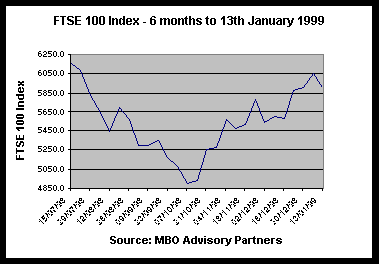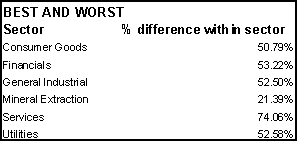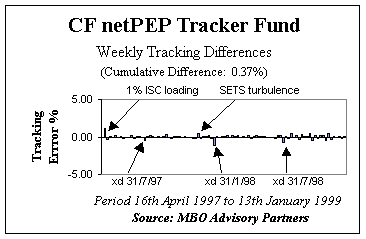This report covers the six month period 16th July 1998 to 13th
January 1999. During this period the FTSE 100 Index fell 250 points from 6156.1 to 5906.1
a drop of 4.06%. This compares with netPEP’s offer price which fell from 144.05 to
138.52, a drop of 3.84% well within the investment managers estimated tracking error range
of plus or minus 0.4% per annum. Big Swings

The Emerging Marker Effect
With the market down 20% and up 20% the Financial Times was prompted to
write recently, " If you are going to buy shares these days, you have to have strong
nerves and a map". Most of the volatility over the past 5 years has been on account
of serious economic crises in the emerging markets. It happened in 1994 with the Mexican
peso crisis, the phenomenal debt crisis in Thailand in 1997, Russia in 1998 and now Brazil
in 1999. But it has been right not to have been panicked out of the market despite the
wild swings, adding weight to the argument that private investors are probably better
investors than the professionals because they take the longer term view. The professionals
on the other hand are prone to taking a short term view because of the competitive
pressures caused by short term comparisons with their benchmark indices and the peers.
Best & Worst
Price volatility inevitably shows up big differences between the shares
comprising the Index but it is worth noting in the table below the extraordinarily wide
variations between shares within the same class.

The biggest difference is in the Services sector where Kingfisher
(otherwise known as Woolworths) was up 30% whereas United News & Media was down 44%.
Given that the performance period is only six months these variations are very large and
make the job of stock selection very complex and demonstrates the value of tracker funds.
Top 5 performers were Orange which beat the Index by a wide margin of
40% followed by Kingfisher, Vodafone, Hays and Standard Chartered which beat the Index by
34%, 27%, 22% and 21% respectively. Standard & Chartered has at last managed to change
its share price fortunes after suffering so badly in the early part of last year on
account of the Asian economic crisis.
Bottom performers were P&O, Tomkins, British Airways, United News
& Media and ICI which under-performed the Index by margins of 32%, 34%, 38%, 40% and
44% respectively.
Ins and Outs
There have been a large number of new entrants to the hallowed club of
Britain’s top 100 companies including Nycomed Amersham which came in and went out
again in seven months. ASH the anti-smoking lobby will be disappointed that Imperial
Tobacco and Gallaher both entered the Index. However, the popular high street electrical
retailer, Dixons came in as well as Allied Zurich which was the result of the merger of
BATS financial services interests with Zurich Life. And finally old timer Hanson which has
had a holiday from the FTSE 100 club since it demerged itself some years ago has rejoined.
Other companies to appear include Colt Telecom, Scottish & Southern,
Energy Group, Securicor and Telewest.

Disappearing acts were performed by Blue Circle, British Steel,
Enterprise Oil, LASMO, Next, Rank, RMC and Wolseley. All these changes have a profound
affect on the performance of tracker funds because every time a change occurs transaction
costs arise which the Index makes no allowance for. It is therefore pleasing to note the
very modest tracking error of netPEP’s Tracker Fund as at 13th January
1999 of 0.37% since the fund was launched in April 1997. The graph below illustrates the
weekly tracking differences since launch. |